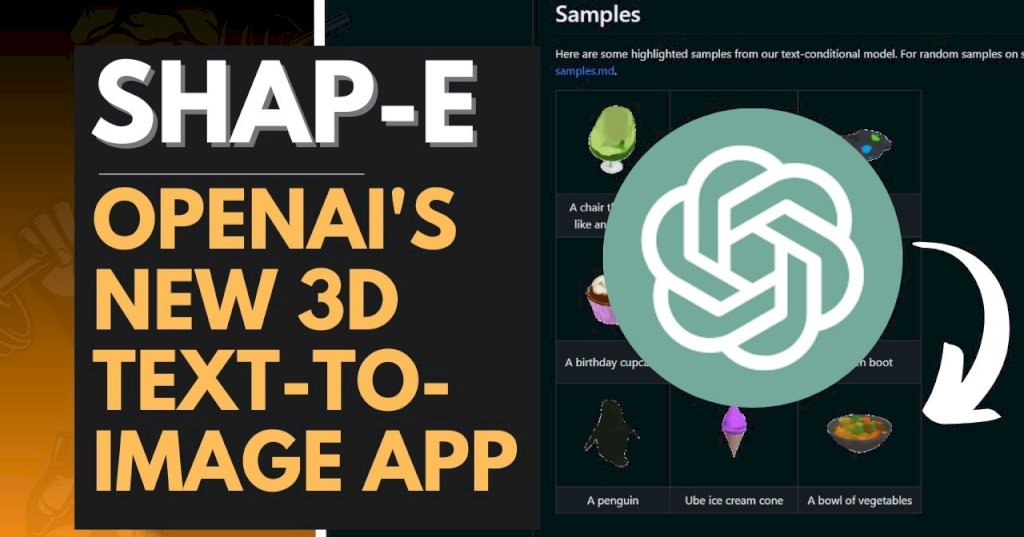The AI powerhouse OpenAI is now one of the leading technological and AI research institutes and seems to be on the upswing with many competitive edges.
After the most notable achievement regarding the development of the GPT, and its next version with enhanced capabilities, the company is preparing to launch its cutting-edge and latest AI tools that include features for the benefit of humanity.
In May 2023, Alex Nichol and Heewon Jun, OpenAI researchers, and collaborators, released a paper announcing Shap-E, the company's latest innovation, a model that turns text prompts into three-dimensional objects in just several seconds.

OpenAI's latest model enables users to create realistic and high-quality 3D models by simply inputting texts or 2D images. In other words, Shap-E is a new tool trained on a huge dataset of concatenated 3D images and text that can create 3D models from text or images.
It is known that this latest generation AI tool has been claimed to produce much more accurate feedback than the similar tool Point E introduced by OpenAI in 2022. This is considered another outstanding breakthrough for the company. OpenAI follows the success of the Dall-E text-to-image generator. It is similar to DALL-E, which can create 2D images from text, but Shap-E generates 3D content.
Technological techniques used in Shape-E
Shap-E is developed by conditional diffusion modeling and 3D projection mapping. About Mapping 3D, it means that Shap-E links written descriptions or visual representations with corresponding 3D models from a vast data set of existing and current 3D objects. A conditional diffusion model is a generalized model that starts from a noisy version of the targeted output and gradually refines it by removing noise and adding details.
By combining these two components: the conditional diffusion model and the 3D content mapping, Shap-E can create diverse and realistic 3D models that best match the input texts or images. and can be viewed from different angles and lighting conditions.
How can you use OpenAI's Shape-E?
Shap-E is now available for download on the GitHub page. You can download the Shap-E for free on GitHub, which runs locally on your PC. You also need a high-performance NVIDIA GPU and CPU to render data in minutes instead of hours because Shap-E is resource-intensive.
You can open the resulting 3D images in Microsoft Paint 3D. Likewise, you can convert images to STL files if you want to print them with a 3D printer.

When you face any troubles with using Shape-E, raising issues on the Shap-E GitHub page is so convenient for you. Also, you can find solutions to problems raised by others on that same page.
However, this free-to-run program is a bit more difficult to install and set up than ChatGPT, the company's ever-popular chatbot. While the basic knowledge of this Shap-E model seems quite simple, according to a report on Tomshardware.com, getting this tool up and running is quite challenging because the insights of technology can be required to install and run the model.
Most of the input is text with simple object descriptions and key details missing, but Shap-E will do its best to accommodate your requirements and create stunning and realistic 3D models that can be viewed in many diverse lighting conditions and angles. Then, the output is a color-animated GIF or a monochrome PLY file that can be opened in programs like Paint 3D.
What can you do with OpenAI's Shape-E?
An architect can make use of Shap-E to get 3D models of buildings and structures by text inputs. You can specify the structure's size, material, color, and style with simple sentences. For example, you can prompt it with: "Create a corn-shaped skyscraper with 60 floors" or "Create a 3-floor house with glass railings", then if you like those natural 3D model results, you can easily export them to other software for further editing.
In engineering, you can describe the components, specifications, and functions of machines and equipment and get the results in a 3D model before creating a physical prototype. Players and animators can enhance the virtual environment and visual experience by creating complex 3D objects and characters.
Additionally, Shap-E can bring many benefits even in the education field when it enables educators to communicate complicated ideas and abstract knowledge to their students in 3D subjects such as biology, geometry, and physics. As a result, effective learning in the educational environment will be improved significantly.

With Shape-E, you can create 3D models of objects for computer games, character objects for movies, virtual reality experiences, engineering simulations, and most importantly, for research science.
Shap-E is an impressive demonstration of the AI's power in creating realistic 3D models from text inputs, natural language, or images. While output quality is not fully guaranteed, AI modeling gives you a quick and efficient way to create 3D models of a bunch of things. Besides, this AI model is an important contributor to the deep learning space and can potentially lead to cutting-edge innovations and creations in the future.




